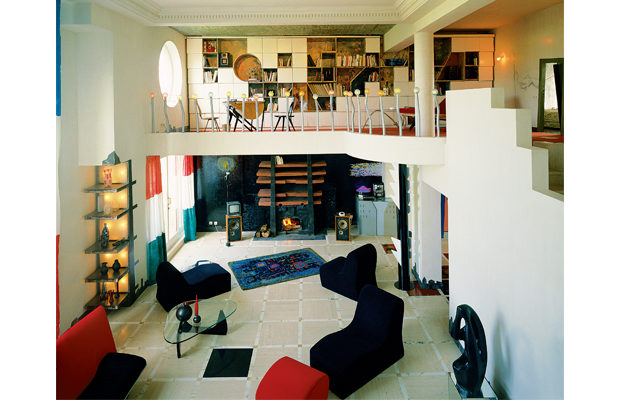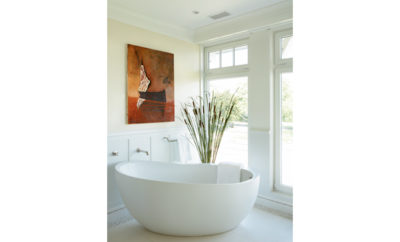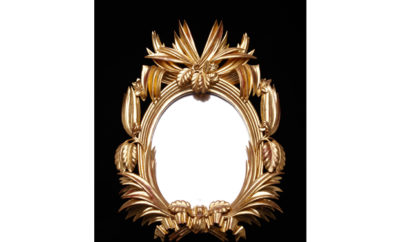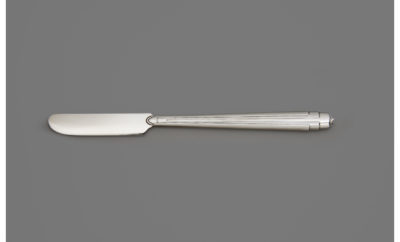
Feature
Agent Provocateur

The view from the guest bedroom takes in the lofty bi-level living and work area, and architectural quirks such as the way a circular second-floor window is echoed in a circular shelving space.
Agent Provocateur:
A look back at a Paris apartment where Gaetano Pesce explored the perfection of imperfection
“When we talk about an interior, if you go somewhere familiar, nothing happens because you know it already, and there is nothing to move your brain to understand something different,” says Italian-born architect and designer Gaetano Pesce. “But new things provoke people to think. And that is why innovation matters so much. Not only is progress in technology and economics important, but so is progress in ways of thinking. That is why creativity is important. Because it provokes the progress of the human being…and that is vital because when you go in a space where nothing provokes you, then nothing happens.”
Pesce has had an unusual, ingenious, and continually evolving career since he began work in the 1960s. Recent projects include customizable shoes for the Brazilian firm Melissa, various new furniture and object designs, and a sensational installation called “Italy on the Cross,” unveiled at the Milan furniture fair this past April. His work has included all manner of exploration, from written manifestos, drawings, chairs and furniture, to architectural projects. Yet there have been few wholly-conceived interiors—gesamtkunstwerks, to use the German term—that he has designed. The most important of these, though no longer extant, was the apartment he reconfigured for the late art collector and art-and-design aficionado Marc-André Hubin, completed in 1986. Situated in a 1930s art deco building on Avenue Foch in Paris near the Arc de Triomphe, this strangely beautiful apartment illustrates perhaps better than any project, Pesce’s artistic goal of using innovation to prompt an alertness to the human narrative and our shared imperfection. By examining specific aspects of the Hubin apartment, along with Pesce’s own words on the subject, we see how a traditional apartment was transformed through a dramatic staging of a multitude of almost mythic tales.
“I do projects not as a profession, but when I have something to express,” says Pesce. “Hubin allowed me to do a kind of portrait of himself, because he was a collector—very curious, very open. So I was able to make a house in a new way. Each door has a different function, so each door is different. Take the workshop, for example. He was a photographer and had a darkroom, so the door to the workshop was a hand, because you work with the hand. And he was a dreamer, so the bird [drawn around the door] represents freedom.”
Pesce’s structural goal was to reorganize the space in a simple way, unifying the apartment both horizontally and vertically by breaking down the divisions of space. But his artistic aims went further. More installation art than interior design, Pesce’s creation is a dramatic mise-en-scène filled with plot lines and character. He established momentary tensions of balance, form, color, and function, and employed strong contrasting colors of red, yellow, blue, and green. Table legs canted inward at various angles. Doorknobs in unusual forms hung at different heights. The balustrade along the mezzanine was made up of skewed stanchions, each surmounted by an illuminated sphere of a different color. Figurative imagery filled the decor. A corner of a wall was chipped away, and lights were inset along a long faux crack in the ceiling. For the inhabitant-viewer, these interventions incited an inner conflict, which in turn spurred questions. For Pesce, this was the ultimate goal. Without this provocation, there would be no reaction and therefore no change.
“There was a huge window onto the terrace, overlooking the Arc de Triomphe, where usually they had a huge French flag in the middle of the arch, moving beautifully,” Pesce recalls. “So I hung double-height curtains with the colors of the flag, and when the window was open in summer, the curtain blew outward, and from the street you would see the same thing that was happening on the Arc de Triomphe.”
The window curtains mimicked the flag, connecting with and drawing in the history of that famous landmark. The fabric related the public discourse with the private; the objective nature of history to the subjective nature of life and living. Or, as Pesce may prefer, the subjective nature of history and the objective nature of life. And throughout the main room and upstairs, a silhouette evocative of the Parisian skyline, cut of contrasting dark marble, was inset along the base of the walls: another story of the city as a counterpoint to the private space.
The aesthetic colloquy was taken further on the apartment’s upper floor. The guest bedroom wall opened or closed to the main room via a garage-like door, either to integrate the private room with the public space, or to further isolate it. Lead, a nod in metal to the rooftops of Paris, was used for furniture in the bedroom. “I try to give to my objects a form that connects with the place where they are realized,” says Pesce. “I try to make objects that carry an idea of joy or an idea of sensuality. We need that.”
Pesce’s use of color is almost expressionistic, but his surrealist gestures are equally key in his interiors. Take the bed in the master suite, which resembled a giant paper- and twine-wrapped package. “Think about a bed,” he says. “If you go to bed with someone, you don’t know what might happen. The bed represents that.” He rigged a system of pulleys whereby the “package” opens up and reveals the mattress within.
But to design a space punctuated by what he calls “symbolic incidents” is only part of Pesce’s method. Another significant layer to his work is his process and idiosyncratic aesthetic language. “I believe that the pursuit of perfection is the wrong goal,” he explains. “In reality, it is good to show that we are human beings and we can make mistakes. We are not supposed to do something that doesn’t represent us. I am not able to do something perfectly round, so I do something that is not round. But it’s okay, because it represents me. It’s a way to talk about individuality, talk about a person, in opposition to the machine.”
For Pesce there is no repetition. He began in the 1960s to develop the concept of a diversified series, in which he seeks to produce objects where uniqueness rather than conformity transcends. Thus, he incorporates elements of chance in art-making, allows for “mistakes” in form and surface, and values the results of somewhat uncontrolled production methods. So if a series of ten vases is made, each will be different from the others. In the Hubin apartment, he employed diversification in a different way. Through the creation of theatrical moments, each experience of the space is punctuated by the chance encounters he staged. Through the use of powerful and subjective narratives, he created a space that could not be duplicated in another location, or for another person. The space was unique to Avenue Foch and to Marc-André Hubin. Pesce sought to exploit and highlight the imperfections of himself and of his client/audience—understanding that no one person is perfect, that each comes with their own set of knowledge and understanding defined by so many personal traits and histories. For Hubin Pesce made a space that reflected his client’s character in whole. To some, the results were perhaps unnerving; to others, comforting; but to all, a provocation.












